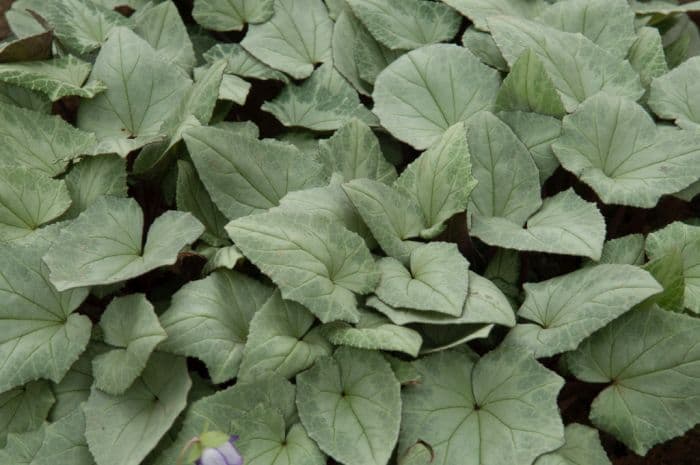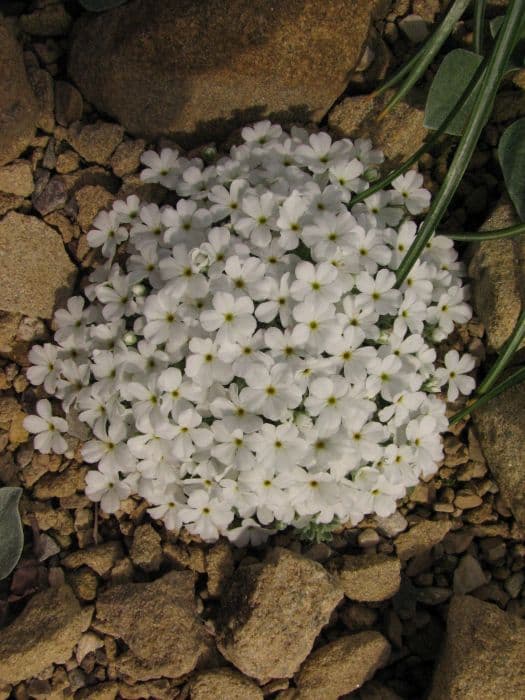Ivy-leaved Cyclamen Cyclamen hederifolium Silver-leaved Group

ABOUT
Cyclamen hederifolium Silver-leaved Group, otherwise known simply as cyclamen, is a distinctive plant known for its attractive foliage and dainty blooms. The leaves are particularly striking, featuring a heart or ivy-like shape with a silver overlay that creates a marbled effect. The coloration can vary but is typically a mix of green with silver patterning. This variety is sought after for this decorative foliage which provides a contrasting backdrop to its flowers. The flowers of the cyclamen have an elegant, swept-back appearance, resembling a group of tiny, winged creatures hovering above the foliage. They bloom atop slender stems, which rise up gracefully from the base of the plant. The petals are reflexed, meaning they are turned outwards, giving the flowers a sense of delicate movement. They come in shades that include pinks, whites, and occasionally deeper tones like purples and reds. As it is a member of the Silver-leaved Group, the plant has a particular charm when light shines upon it, accentuating the silvery tones on the leaves and highlighting the subtle beauty of its flowers. Overall, the cyclamen is a plant that exudes an almost whimsical elegance, making it a favorite for those who appreciate delicate and decorative foliage paired with understated floral beauty.
About this plant
 Names
NamesFamily
Primulaceae.
Synonyms
Ivy-leaved Cyclamen, Neapolitan Cyclamen, Sowbread.
Common names
Cyclamen hederifolium Silver-leaved Group.
 Toxicity
ToxicityTo humans
Cyclamen contains saponins, which are toxic if ingested. Consumption of any part of the cyclamen plant can lead to symptoms such as nausea, vomiting, and diarrhea. In some cases, ingestion can also result in abdominal pain. Contact with the skin may cause irritation or allergic reactions in sensitive individuals. It is important to handle cyclamen with care and keep it out of reach of children to prevent accidental ingestion.
To pets
Cyclamen is toxic to pets, including cats and dogs. The most toxic part of the plant is the tuber (root). If a pet ingests any part of the cyclamen plant, it may experience symptoms such as salivation, vomiting, and diarrhea. In severe cases, ingesting cyclamen can lead to heart rhythm abnormalities, seizures, and even death. It is crucial to keep cyclamen plants out of reach of pets and to seek veterinary care immediately if you suspect your pet has ingested any part of the plant.
 Characteristics
CharacteristicsLife cycle
Perennials
Foliage type
Deciduous
Color of leaves
Variegated
Flower color
Pink
Height
4-6 inches (10-15 cm)
Spread
6-9 inches (15-23 cm)
Plant type
Bulb
Hardiness zones
5
Native area
Mediterranean
Benefits
 General Benefits
General Benefits- Ornamental Appeal: The unique silver-leafed foliage and delicate flowers add aesthetic value to gardens and indoor settings.
- Low Maintenance: Requires minimal care, making it suitable for gardeners of all skill levels.
- Seasonal Interest: Provides autumn color when many other plants are dying back, with flowers that bloom from late summer to autumn.
- Drought Tolerance: Once established, it can withstand periods of dryness, reducing the need for frequent watering.
- Shade Tolerance: Thrives in partial shade, making it ideal for woodland gardens or darker areas of the landscape.
- Naturalizing: Spreads over time to form attractive clumps, and can naturalize in suitable climates.
- Deer and Pest Resistance: Generally resistant to deer and other pests, thus requiring less intervention and reducing the need for pesticides.
- Long Lived: Known for being a long-lived plant, providing many seasons of enjoyment without the need for frequent replanting.
- Non-Invasive: Though it can naturalize, it’s not considered invasive and tends to be manageable within its planted area.
 Medical Properties
Medical PropertiesThis plant is not used for medical purposes.
 Air-purifying Qualities
Air-purifying QualitiesThis plant is not specifically known for air purifying qualities.
 Other Uses
Other Uses```html
- Cyclamen hederifolium, commonly known as ivy-leaved cyclamen, can be used for creating dry shade gardens under trees where other plants may struggle to grow.
- As a natural insect deterrent, the leaves of ivy-leaved cyclamen can sometimes be placed in areas to discourage unwanted pests, though this is not a primary use.
- The tubers of ivy-leaved cyclamen can be processed to extract starch for use in the textile industry as a thickener or a fixative.
- Dried and powdered cyclamen tubers were historically used for washing clothes due to their saponin content.
- Ivy-leaved cyclamen can be utilized in dried floral arrangements, as the seed heads create an interesting visual texture.
- The plant's ability to spread and form a ground cover makes it useful for erosion control on slopes and banks.
- Ivy-leaved cyclamen's vibrant and patterned foliage can be used for botanical illustration and photography subjects.
- As a companion plant, ivy-leaved cyclamen can provide ground cover and visual interest in the dormant winter period for deciduous shrubs and trees.
- Cyclamen tubers have been used in traditional soap making in some cultures due to their saponin content.
- Container gardening is another use for ivy-leaved cyclamen, as their compact growth habit makes them suitable for pots and hanging baskets.
Interesting Facts
 Feng Shui
Feng ShuiCyclamen is not used in Feng Shui practice.
 Zodiac Sign Compitability
Zodiac Sign CompitabilityCyclamen is not used in astrology practice.
 Plant Symbolism
Plant Symbolism- Deep love: Cyclamen are often associated with lasting and sincere affection, making them a symbol of deep love.
- Devotion: The perseverance of the cyclamen to bloom year after year is a testament to devotion.
- Sincerity: The purity of the cyclamen's blossoms is often related to the quality of sincerity in feelings.
- Goodbye: In some cultures, cyclamen are given as a parting gift to symbolize a respectful goodbye or a wish for happiness upon departure.
- Motherly love: The nurturing way cyclamen care for their tubers is reflective of the caring nature of a mother's love.
 Water
WaterIvy-leaved cyclamen should be watered moderately when in active growth, which usually means in the fall and winter. During this period, water them thoroughly whenever the soil surface feels dry, using lukewarm water to avoid shocking the plant's roots. Approximately 8 ounces of water every week should be sufficient, but this can vary depending on the humidity and temperature of the environment. Make sure the pot has good drainage to prevent water from sitting at the bottom, as cyclamen are susceptible to rot when overwatered. Reduce the watering once the leaves start to yellow and the plant goes dormant, usually in late spring to early summer, and resume when new growth appears in late summer.
 Light
LightIvy-leaved cyclamen prefers bright, indirect light and should be placed in a location that mimics their natural environment, such as an east or north-facing window that receives light but is shielded from direct sunlight. Avoid placing them in direct sun, especially during the hot summer months, as this can scorch their leaves.
 Temperature
TemperatureIvy-leaved cyclamen thrives in cooler temperature conditions and prefers an environment that ranges between 50°F and 68°F. It's important to keep them away from heat sources and sudden temperature changes, which can stress the plant. Avoid temperatures above 68°F and below freezing, as extremities beyond these limits can be damaging to the plant.
 Pruning
PruningIvy-leaved cyclamen do not necessarily require pruning, but spent flowers and yellowing leaves should be removed to encourage new growth and maintain the plant's appearance. This can be done as needed throughout the growing season. The best time for this light pruning is after flowering, when the plant is starting to go dormant.
 Cleaning
CleaningAs needed
 Soil
SoilThe best soil mix for Ivy-leaved Cyclamen is light, porous, and well-draining with added organic matter such as leaf mold or peat. It prefers a slightly acidic to neutral pH ranging from 6.5 to 7.0.
 Repotting
RepottingThe Ivy-leaved Cyclamen typically requires repotting every couple of years or when it has outgrown its pot. It's best to repot after the dormant period.
 Humidity & Misting
Humidity & MistingThe Ivy-leaved Cyclamen thrives in moderate humidity levels; it can tolerate indoor humidity but avoid excessively dry air.
 Suitable locations
Suitable locationsIndoor
Place in bright, indirect light; let soil dry slightly between watering.
Outdoor
Partial shade; well-draining soil; shelter from extreme weather.
Hardiness zone
5-9 USDA
 Life cycle
Life cycleCyclamen hederifolium Silver-leaved Group, commonly known as ivy-leaved cyclamen or sowbread, begins its life cycle as a tuber, which sprouts roots, leaves, and flowers. Typically, this occurs in late summer or early fall when the leaves unfurl, often with a stunning silver-marbled patterning. The flowers soon emerge, displaying delicate shades of pink with a magenta blotch at the base, blooming from late summer to autumn. After pollination, usually by ants or other insects, the plant sets seed with the spent flower stems coiling into spirals that bring the seeds closer to the ground. Through the winter and spring, the leaves photosynthesize, storing energy in the tuber until the foliage dies back in late spring to early summer, entering a period of dormancy during the hottest part of the year. The cycle restarts when temperatures cool, and the tuber again sprouts new leaves and flowers.
 Propogation
PropogationPropogation time
Late summer to early autumn
Propogation: Cyclamen hederifolium, commonly known as ivy-leaved cyclamen, is typically propagated by seed. The best time to sow cyclamen seeds is in summer or early fall, which allows for enough time for the seeds to germinate and the seedlings to establish before the winter. Seeds of Cyclamen hederifolium Silver-leaved Group should be sown on the surface of a well-draining potting mix, covered with a thin layer of soil or vermiculite, and kept at a temperature of around 59 to 68 degrees Fahrenheit (15 to 20 degrees Celsius). It can take several weeks to months for cyclamen seeds to germinate. It is important to maintain a humid environment during germination by covering the pot with a plastic bag or placing it in a greenhouse. Once seedlings appear, they should be gradually acclimated to normal conditions and can be potted on when large enough to handle.









